- Accueil
- Pages cachées
- 02 MAI 2024 NEWS
02 MAI 2024 NEWS
INSTITUT SUPERIEUR D'ANTHROPOLOGIE
INSTITUT OF ANTHROPOLOGY
COURS ONLINE – COURS A DISTANCE
INSCRIPTIONS OUVERTES
REGISTER NOW
CHINE - 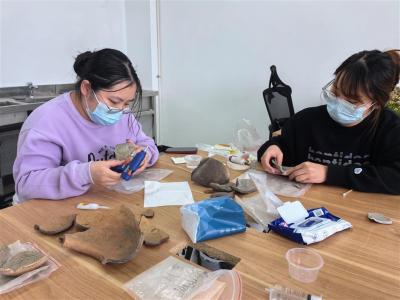 Fujiazhi - The department is digging the Fujiazhi Relic Site near Baima Lake, which is believed to have belonged to the Yue Kingdom from the Spring and Autumn Period (770-476 BC) to the Warring States Period (475-221 BC). The antiques that have been unearthed so far prove that theory. Modern-day Zhejiang Province developed from the ancient Yue Kingdom and is still defined by characteristics of the Yue culture. Fujiazhi is expected to provide archeologists with clues of how the Yue people lived throughout the course of history. In addition, Fujiazhi also boasts Neolithic period relics. In 1989, a villager found a stone axe when he was clearing land. Professionals identified the axe as from the nearby Kuahu Bridge Neolithic Site. The excavation of the Kuahu Bridge site took more than 12 years and yielded many important archaeological discoveries. Grains discovered there indicate that rice was harvested in the area 1,000 years earlier than previously thought.
Fujiazhi - The department is digging the Fujiazhi Relic Site near Baima Lake, which is believed to have belonged to the Yue Kingdom from the Spring and Autumn Period (770-476 BC) to the Warring States Period (475-221 BC). The antiques that have been unearthed so far prove that theory. Modern-day Zhejiang Province developed from the ancient Yue Kingdom and is still defined by characteristics of the Yue culture. Fujiazhi is expected to provide archeologists with clues of how the Yue people lived throughout the course of history. In addition, Fujiazhi also boasts Neolithic period relics. In 1989, a villager found a stone axe when he was clearing land. Professionals identified the axe as from the nearby Kuahu Bridge Neolithic Site. The excavation of the Kuahu Bridge site took more than 12 years and yielded many important archaeological discoveries. Grains discovered there indicate that rice was harvested in the area 1,000 years earlier than previously thought.
Archeologists unearth history at Fujiazhi Relic Site near Baima Lake - SHINE News
ITALIE – 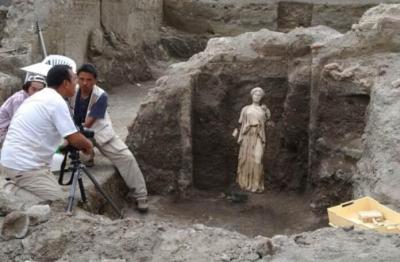 Vesuve - Excavations of a Roman villa dating to the start of the Imperial era show it may belong to the greatest of all the Roman emperors, Caesar Augustus. Called the Somma Vesuviana, the villa was partially destroyed and buried by the same eruption that buried the city of Pompeii in 79 CE, but is located on the northern slopes of the mountain, the site where Augustus is said to have died at the end of a long rule. Roman sources say he died in a villa north of Vesuvius, but scant further details remain. What might illuminate the matter would be evidence of extensive wealth worthy of a man who, in his own words, found Rome a city of stone and left it a city of marble. At the moment, the Somma Vesuviana is being excavated by a team of Japanese researchers from the University of Tokyo who have been working in the area since 2022, and who recently released a statement on their progress. “This archaeological discovery will be a key to unlocking an important phase in human history: the beginning of the ancient Roman Empire and emperor worship,” the translated statement read. Indeed Roman sources say that the site where Augustus died was consecrated following his death, and the original structures buried by Vesuvius were used as an outline for a subsequent building constructed over top of it. “[R]ecent excavations have revealed some rooms of the building before the eruption in 79 CE. So far, four rooms and spaces have been identified,” the statement explains. “In particular, in what we call Room 22, as many as 16 earthenware vessels (amphorae) were found for transporting and storing wine and other items, many of which remained leaning against the walls. On the floor of a small space called Room 25, a large amount of charcoal and ash from the fire was found. This is thought to be the part of the kiln where water is thought to have been boiled.”The evidence of a fire-heated bath points to someone of great personal wealth, though many Romans among the patrician class had such bathing halls. Greater evidence for it being Augustus’ villa comes from the second structure. Much larger, and featuring brick arches, marble columns, and marble statues such as depictions of Dionysus, the god of wine, were all newly installed. The Japanese team described the second structure as “public in nature” due to its size and ornamentation. By the time of the end of the Western Roman Empire, the building had been adapted for mass wine production all before being buried yet again by the smoking behemoth to the south around the turn of the 5th century.
Vesuve - Excavations of a Roman villa dating to the start of the Imperial era show it may belong to the greatest of all the Roman emperors, Caesar Augustus. Called the Somma Vesuviana, the villa was partially destroyed and buried by the same eruption that buried the city of Pompeii in 79 CE, but is located on the northern slopes of the mountain, the site where Augustus is said to have died at the end of a long rule. Roman sources say he died in a villa north of Vesuvius, but scant further details remain. What might illuminate the matter would be evidence of extensive wealth worthy of a man who, in his own words, found Rome a city of stone and left it a city of marble. At the moment, the Somma Vesuviana is being excavated by a team of Japanese researchers from the University of Tokyo who have been working in the area since 2022, and who recently released a statement on their progress. “This archaeological discovery will be a key to unlocking an important phase in human history: the beginning of the ancient Roman Empire and emperor worship,” the translated statement read. Indeed Roman sources say that the site where Augustus died was consecrated following his death, and the original structures buried by Vesuvius were used as an outline for a subsequent building constructed over top of it. “[R]ecent excavations have revealed some rooms of the building before the eruption in 79 CE. So far, four rooms and spaces have been identified,” the statement explains. “In particular, in what we call Room 22, as many as 16 earthenware vessels (amphorae) were found for transporting and storing wine and other items, many of which remained leaning against the walls. On the floor of a small space called Room 25, a large amount of charcoal and ash from the fire was found. This is thought to be the part of the kiln where water is thought to have been boiled.”The evidence of a fire-heated bath points to someone of great personal wealth, though many Romans among the patrician class had such bathing halls. Greater evidence for it being Augustus’ villa comes from the second structure. Much larger, and featuring brick arches, marble columns, and marble statues such as depictions of Dionysus, the god of wine, were all newly installed. The Japanese team described the second structure as “public in nature” due to its size and ornamentation. By the time of the end of the Western Roman Empire, the building had been adapted for mass wine production all before being buried yet again by the smoking behemoth to the south around the turn of the 5th century.
Archaeologists May Have Found the Villa Where the Roman Emperor Augustus Died (goodnewsnetwork.org)
SUEDE 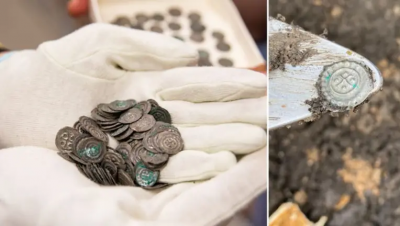 Brahekyrkan - During archaeological excavations in a medieval graveyard in Brahekyrkan on the Swedish island of Visingsö, archaeologists uncovered about 170 silver coins dating back to the mid-12th century. The silver coins were found in the grave of a man that experts believed was between 20 and 25 years old when he died. The pieces of metal were produced between 1150 and 1180. 170 silver bracteates were found in total. A bracteate is a piece of thin, coin-shaped metal that was used as jewelry. The find is extremely unique, partly because there are few similar finds from the period, and partly because some of the coins were completely unknown before. The excavation also uncovered 24 graves and 20 hearths. A survey in 2005 revealed the presence of hearths at the site, with three dating to 50-400 AD, indicating that activity at the site dates back at least to the Roman Iron Age. What struck the investigators as odd is that the 20 graves were located outside the church wall, on unconsecrated ground. Anna Ödéen commented in a second press release: “During parts of our history, someone who committed suicide could not be given what the church called “an honorable burial” and the same was true for unbaptized children and serious criminals…However, it turned out that it was not just one grave, but many more. All lay in the same direction, well aligned with each other, and at the same depth. It was therefore an organized burial site, where they should also have had a marking above ground.”
Brahekyrkan - During archaeological excavations in a medieval graveyard in Brahekyrkan on the Swedish island of Visingsö, archaeologists uncovered about 170 silver coins dating back to the mid-12th century. The silver coins were found in the grave of a man that experts believed was between 20 and 25 years old when he died. The pieces of metal were produced between 1150 and 1180. 170 silver bracteates were found in total. A bracteate is a piece of thin, coin-shaped metal that was used as jewelry. The find is extremely unique, partly because there are few similar finds from the period, and partly because some of the coins were completely unknown before. The excavation also uncovered 24 graves and 20 hearths. A survey in 2005 revealed the presence of hearths at the site, with three dating to 50-400 AD, indicating that activity at the site dates back at least to the Roman Iron Age. What struck the investigators as odd is that the 20 graves were located outside the church wall, on unconsecrated ground. Anna Ödéen commented in a second press release: “During parts of our history, someone who committed suicide could not be given what the church called “an honorable burial” and the same was true for unbaptized children and serious criminals…However, it turned out that it was not just one grave, but many more. All lay in the same direction, well aligned with each other, and at the same depth. It was therefore an organized burial site, where they should also have had a marking above ground.”
ESPAGNE –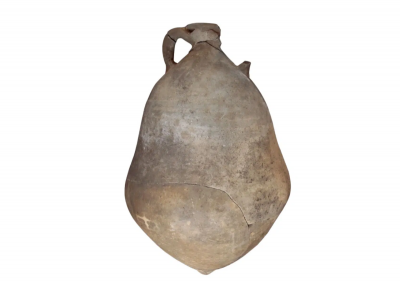
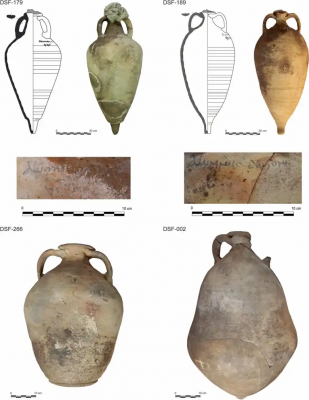 Mallorca - The first in-depth analysis of the cargo of a 4th-century Roman shipwreck found off the coast of Mallorca in 2019 allowed the detection of a new type of amphora. Due to the exceptional preservation of its hull and cargo, the shipwreck Ses Fontanelles, which was accidentally found close to one of the busiest tourist beaches on the island, has proven to be a remarkable discovery. The shipwreck was discovered 65 meters from the coast of a tourist beach near Mallorca’s capital of Palma. Researchers took a multipronged approach to the analysis, using petrographic analysis to determine the origin of the amphorae, residue analysis to determine their contents, and wood and plant analysis on the ship’s hold. Researchers discovered a collection of ceramic objects, primarily amphorae, used to store and transport various items within the ship’s cargo area. The initial study of the materials recovered from the first excavations allowed for the classification of ceramic finds primarily amphorae. According to the petrographic examination of the amphorae, the ship most likely sailed from the Cartagena region, which is located in the Iberian Peninsula’s southeast. They were able to determine that the boat likely departed carrying a cargo of fish sauce, olive oil, and wine in four different types of amphora, including one that hasn’t been found anywhere else before. It has been named a Ses Fontanelles I amphora after the find site. A significant discovery from the study is the recognition of a new kind of amphora, only found in this wreck. The newly identified amphora is larger and heavier than others, and it was mainly used for transporting plant oil. The recovered amphorae from the shipwreck have painted inscriptions called tituli picti, which give important details about where the items came from, what they were, and who owned them. These inscriptions tell us that the makers of the amphorae were Ausonius et Alunni. At the time this ship was transporting goods, liquamen was a fish sauce distinct from garum, the fermented fish condiment that was ubiquitous in Roman repasts. (From the 5th century the two would become synonymous.) The analysis suggests that this fish sauce was mainly made from anchovies (Engraulis encrasicolus), with some sardines occasionally mixed in. On the other hand, organic residue analysis provides information on the contents of the various amphorae. Some show evidence of animal products, possibly related to the fish sauce, but also of grape derivatives, which could have been used as a condiment. The flat-bottomed amphorae, for their part, contained traces of vegetable oil, and in one case, even olives preserved in a grape-based substance. The materials that went into making the ship’s hull were carefully scrutinized. Harder woods such as juniper, olive, and laurel were used for assembly, while pine was used for the main parts. Vine branches and other plants were used as filler and to protect the cargo during the voyage.
Mallorca - The first in-depth analysis of the cargo of a 4th-century Roman shipwreck found off the coast of Mallorca in 2019 allowed the detection of a new type of amphora. Due to the exceptional preservation of its hull and cargo, the shipwreck Ses Fontanelles, which was accidentally found close to one of the busiest tourist beaches on the island, has proven to be a remarkable discovery. The shipwreck was discovered 65 meters from the coast of a tourist beach near Mallorca’s capital of Palma. Researchers took a multipronged approach to the analysis, using petrographic analysis to determine the origin of the amphorae, residue analysis to determine their contents, and wood and plant analysis on the ship’s hold. Researchers discovered a collection of ceramic objects, primarily amphorae, used to store and transport various items within the ship’s cargo area. The initial study of the materials recovered from the first excavations allowed for the classification of ceramic finds primarily amphorae. According to the petrographic examination of the amphorae, the ship most likely sailed from the Cartagena region, which is located in the Iberian Peninsula’s southeast. They were able to determine that the boat likely departed carrying a cargo of fish sauce, olive oil, and wine in four different types of amphora, including one that hasn’t been found anywhere else before. It has been named a Ses Fontanelles I amphora after the find site. A significant discovery from the study is the recognition of a new kind of amphora, only found in this wreck. The newly identified amphora is larger and heavier than others, and it was mainly used for transporting plant oil. The recovered amphorae from the shipwreck have painted inscriptions called tituli picti, which give important details about where the items came from, what they were, and who owned them. These inscriptions tell us that the makers of the amphorae were Ausonius et Alunni. At the time this ship was transporting goods, liquamen was a fish sauce distinct from garum, the fermented fish condiment that was ubiquitous in Roman repasts. (From the 5th century the two would become synonymous.) The analysis suggests that this fish sauce was mainly made from anchovies (Engraulis encrasicolus), with some sardines occasionally mixed in. On the other hand, organic residue analysis provides information on the contents of the various amphorae. Some show evidence of animal products, possibly related to the fish sauce, but also of grape derivatives, which could have been used as a condiment. The flat-bottomed amphorae, for their part, contained traces of vegetable oil, and in one case, even olives preserved in a grape-based substance. The materials that went into making the ship’s hull were carefully scrutinized. Harder woods such as juniper, olive, and laurel were used for assembly, while pine was used for the main parts. Vine branches and other plants were used as filler and to protect the cargo during the voyage.
New Type of Amphora Found in 5th-Century Roman Shipwreck - Arkeonews
IRLANDE – 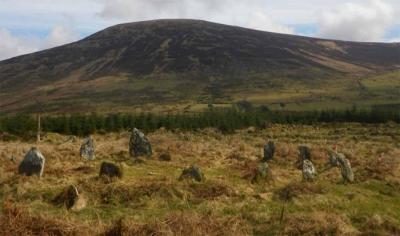
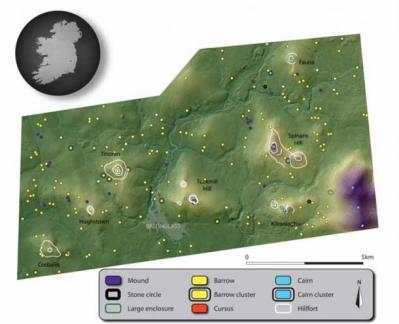 Wicklow - Traces of hundreds of monuments, which were previously unknown, have been identified in an archaeological survey in Ireland. Five of these monuments have been identified as “incredibly rare” prehistoric constructions that may once have contained secret “routes for the dead” leading to the afterlife. The study, led by Dr. James O’Driscoll of the University of Aberdeen and supported by the Community Monuments Fund and Wicklow County Council, employed LiDAR to generate highly detailed three-dimensional models of the terrain. O’Driscoll carried out the survey in the Baltinglass landscape of County Wicklow, Ireland which is dotted with prehistoric remains and the results were published in the journal Antiquity. The area examined by the researchers was occupied during the Early Neolithic (beginning around 3700 B.C.) and the Middle to Late Bronze Age (1400 to 800 B.C.). However, evidence of occupation during a 2,000-year stretch between the two periods, known as the Middle Neolithic, has been scarce — until now. According to O’Driscoll, the finding of the cursus monuments is especially noteworthy because it refutes the conventional wisdom that Baltinglass was abandoned for about 2,000 years, between the Late Bronze Age and the Early Neolithic. These results suggest that the region was consistently inhabited and had ritual importance during these times. In addition to being important architecturally, the cursus monuments that have been found also have important cultural and spiritual significance. These monuments, which mark significant solar events like the solstices, are placed strategically throughout the landscape to coincide with burial sites and the Sun’s cyclical movements. According to Dr. O’Driscoll, this alignment represents the dead’s journey, as they ascend to the heavens and leave behind a tangible trail connecting them to their ancestors’ world on the other side. This connection between the cursus pathways, the burial grounds, and celestial events underscores the intertwined nature of daily life, agricultural cycles, and spiritual beliefs in Neolithic communities, suggesting a complex understanding of life, death, and rebirth. Cursuses are a type of monumental Neolithic structures which are similar to ditches or trenches and are found in the islands of Great Britain and Ireland. These prehistoric monuments generally have long and relatively narrow earthwork enclosures. “The discovery of the cursus monuments is particularly significant, as these are incredibly rare in Ireland,” said O’Driscoll. “There are less than 20 recorded cursus monuments in Ireland, and they typically occur in isolation or pairs. This makes the identification of five examples in Baltinglass the largest cluster of these sites in the country—but also, the detailed topographical model of the sites and their surrounding landscape provided an opportunity to ‘digitally’ investigate these monuments in detail,” he added “The function of these types of monuments has always been a thorny topic, as we simply don’t have enough information. But given that some of the Baltinglass sites can also be linked with burial monuments, this suggested to me that they may have been ceremonial monuments used in burial practices, where the cursus marked the physical route in which the dead moved from the living into the afterlife,” said O’Driscoll.
Wicklow - Traces of hundreds of monuments, which were previously unknown, have been identified in an archaeological survey in Ireland. Five of these monuments have been identified as “incredibly rare” prehistoric constructions that may once have contained secret “routes for the dead” leading to the afterlife. The study, led by Dr. James O’Driscoll of the University of Aberdeen and supported by the Community Monuments Fund and Wicklow County Council, employed LiDAR to generate highly detailed three-dimensional models of the terrain. O’Driscoll carried out the survey in the Baltinglass landscape of County Wicklow, Ireland which is dotted with prehistoric remains and the results were published in the journal Antiquity. The area examined by the researchers was occupied during the Early Neolithic (beginning around 3700 B.C.) and the Middle to Late Bronze Age (1400 to 800 B.C.). However, evidence of occupation during a 2,000-year stretch between the two periods, known as the Middle Neolithic, has been scarce — until now. According to O’Driscoll, the finding of the cursus monuments is especially noteworthy because it refutes the conventional wisdom that Baltinglass was abandoned for about 2,000 years, between the Late Bronze Age and the Early Neolithic. These results suggest that the region was consistently inhabited and had ritual importance during these times. In addition to being important architecturally, the cursus monuments that have been found also have important cultural and spiritual significance. These monuments, which mark significant solar events like the solstices, are placed strategically throughout the landscape to coincide with burial sites and the Sun’s cyclical movements. According to Dr. O’Driscoll, this alignment represents the dead’s journey, as they ascend to the heavens and leave behind a tangible trail connecting them to their ancestors’ world on the other side. This connection between the cursus pathways, the burial grounds, and celestial events underscores the intertwined nature of daily life, agricultural cycles, and spiritual beliefs in Neolithic communities, suggesting a complex understanding of life, death, and rebirth. Cursuses are a type of monumental Neolithic structures which are similar to ditches or trenches and are found in the islands of Great Britain and Ireland. These prehistoric monuments generally have long and relatively narrow earthwork enclosures. “The discovery of the cursus monuments is particularly significant, as these are incredibly rare in Ireland,” said O’Driscoll. “There are less than 20 recorded cursus monuments in Ireland, and they typically occur in isolation or pairs. This makes the identification of five examples in Baltinglass the largest cluster of these sites in the country—but also, the detailed topographical model of the sites and their surrounding landscape provided an opportunity to ‘digitally’ investigate these monuments in detail,” he added “The function of these types of monuments has always been a thorny topic, as we simply don’t have enough information. But given that some of the Baltinglass sites can also be linked with burial monuments, this suggested to me that they may have been ceremonial monuments used in burial practices, where the cursus marked the physical route in which the dead moved from the living into the afterlife,” said O’Driscoll.
INDE – 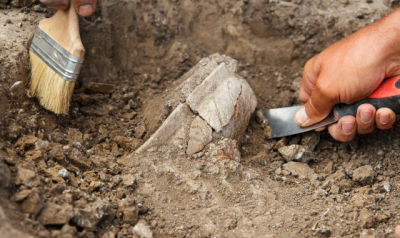 Baghanki - In a fascinating discovery during construction for a new residence in Baghanki village near Manesar three ancient metal idols, estimated to be approximately 400 years old, have emerged. The artefacts, portraying Lord Vishnu and Goddess Lakshmi, and a combined representation of both divinities
Baghanki - In a fascinating discovery during construction for a new residence in Baghanki village near Manesar three ancient metal idols, estimated to be approximately 400 years old, have emerged. The artefacts, portraying Lord Vishnu and Goddess Lakshmi, and a combined representation of both divinities
400-Year-Old Statues Found In Haryana's Manesar (outlooktraveller.com)
CHINE - 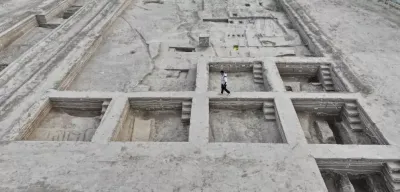 Nanyang - Ruins of eight ancient cities dating back to more than 2,000 years ago were discovered in the Xiong'an New area, suggesting that China's "city of the future" boasts a long history, said local archaeologists. This was reported by The Xinhua News Agency. The earliest ruins, namely Nanyang, included two city sites from the Warring States Period (475-221 B.C.). The Nanyang ruins and its surrounding areas covered nearly 18 square kilometers, with the cultural relics spanning nearly 3,000 years from the Neolithic Age down to the Song Dynasty (960-1279) and Jin Dynasty (1115-1234). Xiong'an was named after two counties Xiongxian and Anxin, where ruins of two cities were found. The Xiongzhou ancient city in Xiongxian was formed in the period of the Five Dynasties and Ten Kingdoms (907-979), of which a few sections of the city walls are still existent. Anxin was home to the Anzhou ancient city that started in the Song Dynasty, where up to three kilometers of city walls, some 1.5 to two meters tall, are still standing. A team of archaeologists started working in May that year for a thorough investigation and survey of cultural relics in the area covering 1,770 square kilometers. To date, they have excavated more than 20,000 square meters, unearthing more than 4,000 pieces of cultural relics including bronze-ware, jade articles, stoneware, porcelain, and mostly, potteries, and identifying 263 immovable cultural relics.
Nanyang - Ruins of eight ancient cities dating back to more than 2,000 years ago were discovered in the Xiong'an New area, suggesting that China's "city of the future" boasts a long history, said local archaeologists. This was reported by The Xinhua News Agency. The earliest ruins, namely Nanyang, included two city sites from the Warring States Period (475-221 B.C.). The Nanyang ruins and its surrounding areas covered nearly 18 square kilometers, with the cultural relics spanning nearly 3,000 years from the Neolithic Age down to the Song Dynasty (960-1279) and Jin Dynasty (1115-1234). Xiong'an was named after two counties Xiongxian and Anxin, where ruins of two cities were found. The Xiongzhou ancient city in Xiongxian was formed in the period of the Five Dynasties and Ten Kingdoms (907-979), of which a few sections of the city walls are still existent. Anxin was home to the Anzhou ancient city that started in the Song Dynasty, where up to three kilometers of city walls, some 1.5 to two meters tall, are still standing. A team of archaeologists started working in May that year for a thorough investigation and survey of cultural relics in the area covering 1,770 square kilometers. To date, they have excavated more than 20,000 square meters, unearthing more than 4,000 pieces of cultural relics including bronze-ware, jade articles, stoneware, porcelain, and mostly, potteries, and identifying 263 immovable cultural relics.
Ruins of eight ancient city sites discovered in Xiong'an New Area | Ukrainian news (ukranews.com)
ISRAEL – 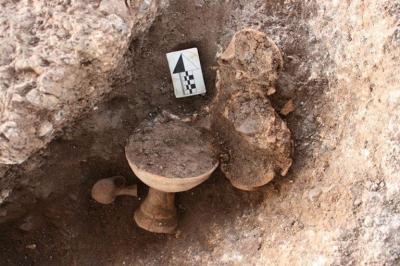 Horvat Tevet - - Archeologists have identified an Early Iron Age cemetery in Israel’s Jezreel Valley dating from the monarchy of the biblical King David more than 3,000 years ago. The ancient burial ground, near the modern city of Afula, is next to Horvat Tevet, a village in which five archeological excavations were conducted between 2011 and 2019. This is the same village where scientists recently used geomagnetic field dating to verify biblical accounts of Egyptian, Aramean, Assyrian and Babylonian military campaigns against the kingdoms of Israel and Judah. A monumental royal house was discovered at the site as well. According to a new paper published in the American Journal of Archaeology, at least 25 shallow graves dated to the Iron I period (11th–10th centuries BCE) are the latest finds revealed. Examining the contents of the graves “sheds light on the social complexity, economy, and funerary rituals of a rural community in the Jezreel Valley in the period between the collapse of Egyptian rule in Canaan and the formation of early monarchic Israel.” The cemetery was first discovered in the course of digging for infrastructure projects back in 2018. Following excavations by the Israeli Institute of Archaeology and the Institute of Archaeology at Tel Aviv University, researchers from Tel Aviv University and the Israel Antiquities Authority studied the site. In the cemetery, they found ceramic vessels containing traces of beeswax that may have been melted and poured over the corpses. One skeleton was clad in linen fabric likely produced at nearby Beit She’an, and wore four ankle bracelets. Chemical analysis of the anklets showed the metal came from the Timna copper mines down south near Eilat. In general, however, the remains indicate that the community was not well-to-do. “Based on the finds in the graves and variations between graves, it is concluded that the site was home to a community characterized by minimal wealth accumulation, limited social division, and few long-distance trade contacts, though there are implications that the site had connections with the Beth-Shean Valley,” write the researchers, Jordan Weitzel, Karen Covello-Paran, Hannes Bezzel, Oded Lipschits and Omer Sergi.The terraced site slopes down to the northern bank of Nahal Tevet (Tevet Stream) overlooking ancient trade routes that connected the Beit She’an and Jezreel Valleys with the Galilee. The archeologists speculate that the people interred here were residents of Horvat Tevet at around the time this Canaanite village was changing hands from the Egyptians to the Israelites. It’s not clear whether they were Hebrews or members of other local tribes that lived in the area.
Horvat Tevet - - Archeologists have identified an Early Iron Age cemetery in Israel’s Jezreel Valley dating from the monarchy of the biblical King David more than 3,000 years ago. The ancient burial ground, near the modern city of Afula, is next to Horvat Tevet, a village in which five archeological excavations were conducted between 2011 and 2019. This is the same village where scientists recently used geomagnetic field dating to verify biblical accounts of Egyptian, Aramean, Assyrian and Babylonian military campaigns against the kingdoms of Israel and Judah. A monumental royal house was discovered at the site as well. According to a new paper published in the American Journal of Archaeology, at least 25 shallow graves dated to the Iron I period (11th–10th centuries BCE) are the latest finds revealed. Examining the contents of the graves “sheds light on the social complexity, economy, and funerary rituals of a rural community in the Jezreel Valley in the period between the collapse of Egyptian rule in Canaan and the formation of early monarchic Israel.” The cemetery was first discovered in the course of digging for infrastructure projects back in 2018. Following excavations by the Israeli Institute of Archaeology and the Institute of Archaeology at Tel Aviv University, researchers from Tel Aviv University and the Israel Antiquities Authority studied the site. In the cemetery, they found ceramic vessels containing traces of beeswax that may have been melted and poured over the corpses. One skeleton was clad in linen fabric likely produced at nearby Beit She’an, and wore four ankle bracelets. Chemical analysis of the anklets showed the metal came from the Timna copper mines down south near Eilat. In general, however, the remains indicate that the community was not well-to-do. “Based on the finds in the graves and variations between graves, it is concluded that the site was home to a community characterized by minimal wealth accumulation, limited social division, and few long-distance trade contacts, though there are implications that the site had connections with the Beth-Shean Valley,” write the researchers, Jordan Weitzel, Karen Covello-Paran, Hannes Bezzel, Oded Lipschits and Omer Sergi.The terraced site slopes down to the northern bank of Nahal Tevet (Tevet Stream) overlooking ancient trade routes that connected the Beit She’an and Jezreel Valleys with the Galilee. The archeologists speculate that the people interred here were residents of Horvat Tevet at around the time this Canaanite village was changing hands from the Egyptians to the Israelites. It’s not clear whether they were Hebrews or members of other local tribes that lived in the area.
Bodies in ancient graveyard likely covered in beeswax - ISRAEL21c




